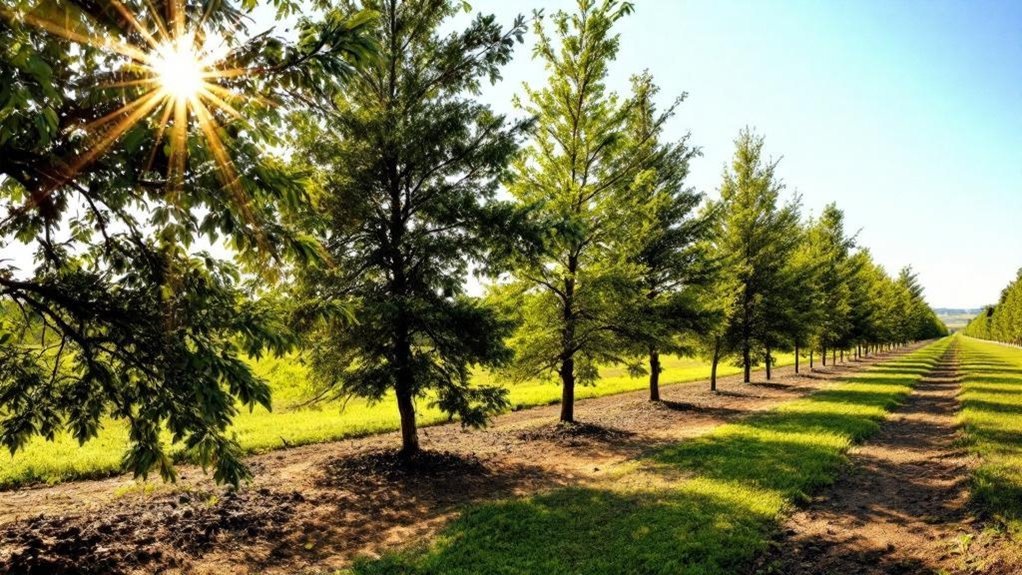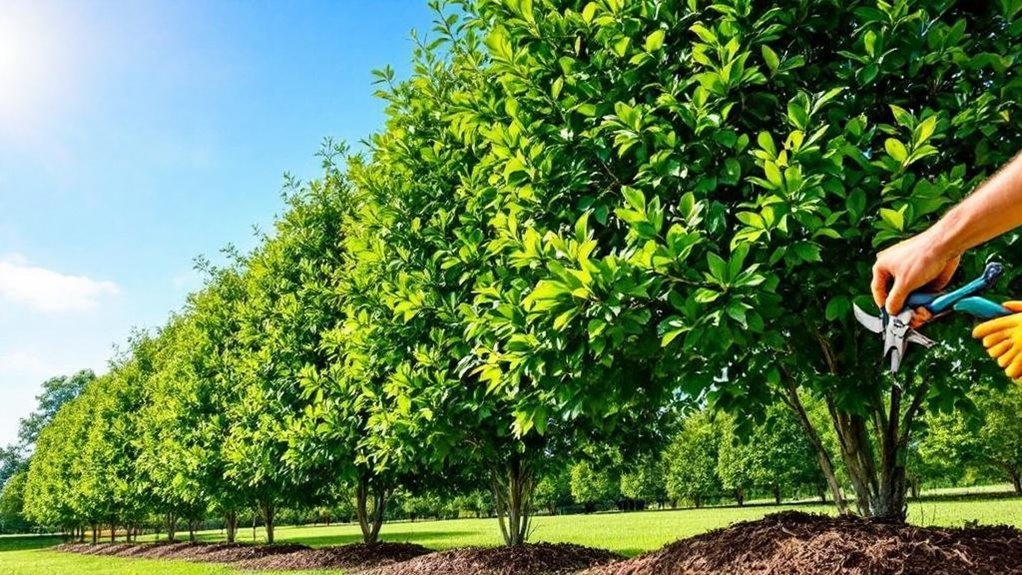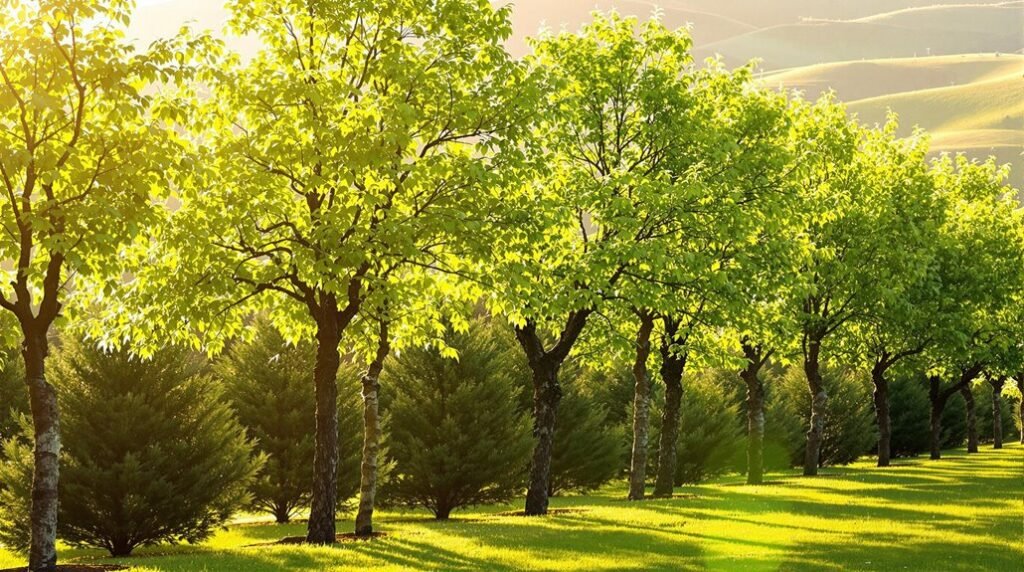You might not realize that planting the right windbreak trees can reduce your home’s heating and cooling costs by up to 20%. These natural barriers do more than just block wind—they protect your property, prevent soil erosion, and boost privacy. However, selecting the proper species and placing them strategically is key to maximizing these benefits. Understanding these factors can help you create an effective, lasting windbreak that truly enhances your outdoor space.
Benefits of Planting Windbreak Trees
When you plant windbreak trees, you’ll not only shield your property from harsh winds but also cut your heating and cooling costs by up to 20%.
A well-designed windbreak, especially using fast-growing evergreen varieties, offers excellent wind protection year-round. These trees reduce wind speed by up to 50%, safeguarding your home and minimizing soil erosion across various soil types.
Fast-growing evergreens form year-round windbreaks, cutting wind speed by up to 50% and protecting soil and homes.
Beyond energy savings, windbreaks create privacy screens, block noise, and improve environmental health by reducing dust and air pollution.
Choosing the best windbreak trees for your needs guarantees effective protection and enhances your outdoor living space.
Choosing the Right Trees for Your Zone
How do you guarantee your windbreak trees thrive and provide maximum protection? Start by selecting the right tree for your hardiness zone. Knowing your zone helps you pick native plants that grow well and form the best windbreaks. For colder zones (3-6), species like Colorado blue spruce, Eastern white pine, and Green giant arborvitae excel. Warmer zones (7-10) benefit from trees such as Eastern redcedar and Chinese juniper.
| Hardiness Zone | Recommended Trees | Benefits |
|---|---|---|
| 3-6 | Colorado blue spruce, Green giant arborvitae | Cold hardy, dense coverage |
| 7-10 | Eastern redcedar, Chinese juniper | Heat tolerant, pest resistant |
| All | Mix species | Pest/disease resistance |
| All | Assess soil/moisture | Guarantees tree health |
Choose wisely when planting trees for lasting windbreak protection.
Strategic Placement and Spacing Guidelines

Although selecting the right trees is crucial, you also need to place and space them strategically to maximize windbreak effectiveness.
For ideal protection, plant windbreaks on the north and northwest sides of your property, where cold winds hit hardest. Space shorter trees about 10 feet apart with 15-20 feet between rows, while taller trees require 15 feet spacing and 25 feet between rows for healthy growth.
Dense planting—at least 65% density—boosts shelter and privacy, especially when you mix evergreens and deciduous trees for year-round protection.
Mapping your yard before planting helps you position trees to reduce wind speed effectively. By following these spacing guidelines, you’ll create a resilient, dense windbreak that not only shields your property but also supports wildlife habitat and energy savings.
Fast-Growing Windbreak Trees for Quick Protection
If you want to establish wind protection quickly, choosing fast-growing trees is key. Fast-growing windbreak trees like Green Arborvitae and Giant Arborvitae can grow 3 to 5 feet annually, providing quick protection and dense privacy.
Norway Spruce, another excellent choice, grows up to 3 feet per year and matures between 40 to 60 feet, offering year-round shelter. Colorado spruce, while slightly slower, still delivers solid windbreak benefits as an evergreen tree that withstands harsh conditions.
These evergreens form a reliable barrier, reducing wind impact while enhancing your property’s privacy. By planting a mix of these fast-growing trees, you’ll create an effective windbreak that offers protection and privacy much faster than slower-growing species.
Maintenance Tips for Long-Term Windbreak Health

To keep your windbreak trees healthy and effective over the years, you’ll need to monitor them regularly for pests and diseases. Early detection helps prevent damage and supports steady growth rates.
As part of maintenance, prune your trees annually to maintain shape and encourage strong branching, which boosts their wind protection. Apply mulch around the base to conserve moisture, improve soil quality, and reduce weed competition.
Water young trees consistently, especially during dry periods, to establish deep roots vital for long-term stability. Every few years, fertilize your windbreak trees with a balanced slow-release fertilizer to supply important nutrients.
Frequently Asked Questions
What Is the Fastest Growing Tree for Windbreak?
You’re looking for the fastest-growing tree, and the Thuja ‘Green Giant’ fits perfectly. It grows 3-5 feet annually, quickly reaching 30-40 feet, making it ideal if you want speedy growth for wind protection.
What Is the Best Tree to Block Neighbors?
You want privacy, yet you crave nature’s beauty; planting Thuja ‘Green Giant’ or Leyland Cypress gives you both. Their dense, fast-growing foliage blocks neighbors effectively while adding vibrant greenery to your space.
Which Type of Trees Are Most Effective in Blocking Wind?
You’ll find evergreen trees, like Norway spruce and Eastern red cedar, most effective for blocking wind. Their dense, year-round foliage creates a solid barrier, reducing wind speed and protecting your property throughout all seasons.
What Is the Most Effective Windbreak?
Think of a fortress shielding you from storms; the most effective windbreak combines diverse evergreens and shrubs. You’ll want dense, layered plants spaced wisely to create a resilient, year-round barrier against harsh winds.
Final Thoughts
Planting windbreak trees is like building a green fortress around your property, shielding you from harsh winds while cutting energy costs. By choosing fast-growing evergreens and placing them strategically, you’ll see quick, lasting benefits like improved privacy and reduced soil erosion. With a little care and maintenance, your natural barrier will thrive for years, creating a comfortable, protected outdoor space you’ll enjoy every season. Start planting today and watch your windbreak grow strong.
